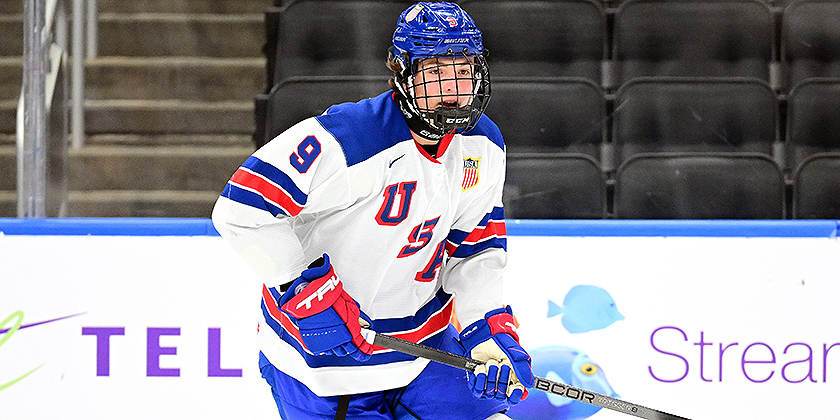
Kade Stengrim (C, L, 6’4″, 205, Youngstown Phantoms, 06/09/2007, St. Cloud)
Kade Stengrim is a big-bodied winger who thrives in the dirty areas, utilizing his frame and touch around the net to be an effective complementary scorer. With limited ice time in the USHL this season (just 8:40 TOI/game), Stengrim’s statistical profile is built on efficiency rather than volume. He’s not a dynamic puck carrier or a high-skill threat, but he is a player who knows how to get to the net, leverage his size in scoring areas, and generate chances with a powerful shot and good hands in tight. There are questions around his skating pace, offensive ceiling, and impact at 5-on-5, but the foundational tools for a bottom-six power forward are evident.
Why Kade Stengrim Should Be an NHL Draft Pick
1) Size and Strength Translate
At 6’4″, 200 lbs, Stengrim is already built like a pro and shows an understanding of how to use his frame. He consistently positions himself net-front on the power play, reverses pressure in board battles, and uses his backside to shield pucks and create space in tight. His puck protection game is advanced for a player in his draft class, even if he’s still learning how to win with leverage (43% puck battle win rate).
2) Efficient Offensive Production in Limited Role
Despite playing under 9 minutes per game, Stengrim generated 1.83 shots, 0.93 Grade A chances, and scored on 16% of his opportunities — a clear sign of finishing ability. His 0.86 loose puck recoveries/game is a reflection of his instincts around rebounds and his ability to find space near the crease. He was opportunistic and productive within his role and earned touches on the second power play unit.
3) Strong Shot Mechanics and Net-Front Instincts
He owns a heavy, quick release that can beat goalies clean off the rush or in traffic. Neutral Zone evaluations from the 2024 National Camp and Select 17s highlight his ability to score from tight angles and soft areas with minimal time and space. He showed a knack for tip-ins, tap-ins, and redirections, indicating good touch and hand-eye coordination in scoring areas.
4) Defensive Engagement and Awareness
When not producing, Stengrim still contributes by getting in lanes, blocking shots, and using his long reach to disrupt plays. His 3.3 giveaways/game is of note considering his TOI but not reckless, and he often earns puck touches back with an active stick and effort tracking. He showed responsibility at National Camp and was praised for his off-puck reads and defensive zone awareness.
Why Kade Stengrim Should Not Be an NHL Draft Pick
1) Limited Ice Time and Role
He played fewer than 9 minutes per game in the USHL and was 13th in team scoring. He was not trusted with tough matchups, didn’t kill penalties, and saw mostly second-unit power play time. This makes it hard to project what his game might look like with a bigger role or at higher levels of pace.
2) Below-Average Passing and Puck Movement
His 81% pass completion and 0.27 pre-shot passes/game reveal limited vision and below-average decision-making with the puck. He can slow the transition game and often doesn’t see second-level passing options. He projects far more as a finisher than a playmaker and may struggle when asked to make quick reads at NHL pace.
3) Skating Needs Work
Stengrim’s stride is heavy, and he doesn’t create separation off the rush or cut laterally to create offense. He often relies on attempting fakes or trying to use speed rather than using his strength and reach to gain space. Without a boost in his explosiveness and footwork, it’s unlikely he’ll keep up with the speed of NHL in transition.
4) Physicality Doesn’t Match Frame
For a 6’4″ winger, 0.46 hits/game is of note. He’s physical when pinned or pressured but rarely initiates with force or uses his size to punish and intimidate opponents. He needs to play with more consistent edge, especially if he wants to create more space for himself offensively. Being big but not mean will limit his effectiveness at the pro level.
Projection & Development Outlook
Player Projection: Bottom-six, net-front specialist with 4th-line power-forward traits
Development Path: Should return to Youngstown with a more defined role in 2025/26 and 2026/27, then move to NCAA hockey. NHL projection will depend on how much strength, pace, and play-processing he can add over the next 3-4 seasons.
Draft Recommendation: 6th–7th Round
Stengrim has NHL translatable traits — size, a heavy shot, net-front value, and some defensive upside — but lacks offensive creativity, pace, and polish. His game is built for a depth role, and he could become a useful depth forward with NHL upside if his skating and physical consistency catch up to his frame. Drafting him late provides a low-risk investment in a long-term power-forward project.
Photo credit: Dan Hickling/Hickling Images
